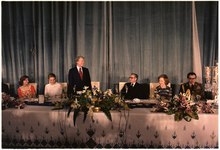Island of Stability (speech)

"Island of Stability"is a phrase that became the namesake for a 1977 speech by American presidentJimmy Carter,while he was being hosted byMohammad Reza Pahlaviat theNiavaran Complexin the city ofTehran,Iran.It was a reflection of Iran's circumstances — regarded as a stable country and a bastion of theWestern Blocin what was otherwise an unstableMiddle Eastunder the influence of theEastern Bloc— and the importance placed on Pahlavi's rule by theUnited States.Carter's speech was made one year before theIslamic Revolution,in which Pahlavi's monarchical state was overthrown and replaced by theIslamic Republic.
Place and date
[edit]In late December 1977, Carter visited Pahlavi in Iran. At a party forNew Year's Eve,held in Tehran's Niavaran Complex, he made a speech describing the American stance on Iran's place in the world order, stating: "Iran is an island of stability in one of the most troubled areas of the world";[1][2]he also described Pahlavi as a popular king among the Iranian people.[3][4]
Consequences
[edit]After Carter's speech, Pahlavi felt encouraged to further suppress his political opponents. One week later, in January 1978, the article "Iran and Red and Black Colonization"was published inEttela'atunder a pseudonym, targetingRuhollah Khomeini.Following the article's publication, several protests occurred inMashhad,Qom,andTehran.Khomeini condemned Carter and described Pahlavi as a tyrant and a traitor to the Iranian nation.[5]
Analysis of the support
[edit]Iranian journalistAhmad Zeidabadiclaimed that Carter was aware of the regional instability spurred by sporadic protests against Pahlavi's rule in Iran, and so he made the speech for Pahlavi as a reassurance of American support.[6]Iranian academicSadegh Zibakalamhas stated that the speech was based on Carter's false impression of Iran's circumstances, and that the American government misjudged the true scope of the Islamic Revolution.[7]
See also
[edit]References
[edit]- ^Dilip Hiro (5 September 2013).Iran Under the Ayatollahs (Routledge Revivals).Routledge. pp. Introduction.ISBN9781135043810.
- ^Manouchehr Ganji (2002).Defying the Iranian Revolution: From a Minister to the Shah to a Leader of Resistance.Greenwood Publishing Group. p. 42.ISBN9780275971878.
- ^Desmond Harney (1999).The Priest and the King: An Eyewitness Account of the Iranian Revolution.I.B.Tauris. p. 2.ISBN9781860643743.
- ^Mark Thiessen (2009).An Island of Stability: The Islamic Revolution of Iran and the Dutch Opinion.Sidestone Press. p. 43.ISBN9789088900198.
- ^Islamic Revolution of Iran: A Sociological Study.Alhoda UK. 2001. pp. 102–104.ISBN9789644723070.Archivedfrom the original on 2022-04-07.Retrieved2024-09-09.
- ^"Carter administration and Iran's revolution".BBC Persian.Archivedfrom the original on 2018-11-27.Retrieved2016-02-13.
- ^Sadegh Zibakalam.End of mirage: An introduction of Islamic revolution.pp. 154–157.
External links
[edit]- Corpus of Political Speeches,publicly accessible with speeches from United States, Hong Kong, Taiwan, and China, provided byHong Kong Baptist University Library
